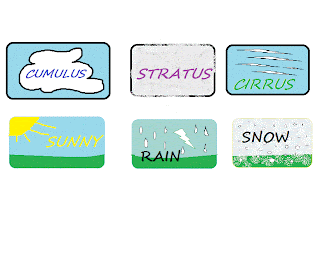An example is a kindergarten through third grade weather log.
1. Make a bulletin board or large chart in which students can put the classroom observations for everyone to see.
2. Teach students to identify the three basic cloud groups, stratus, cumulus and cirrus.
3. Daily, allow students to observe clouds as they spend time on the playground, pass a large window going to lunch or restroom or on a deliberate trip outdoors to look at the clouds.
4. Record on the chart the date, weather (rainy, fair, snow), clouds present.
Before beginning activity, I would have students to make a cumulus, stratus, cirrus, sunny day, rainy day, snowy day picture. Each day when the class records the weather, allow one student to lead the line to lunch, restroom, playground and of course use their picture on the bulletin board for that day.
Students should recognize patterns such as rain and stratus clouds. They may notice cirrus clouds are followed the next day with rain. You can discuss that there are many names for clouds. Mackerel sky comes to mind. Every region has their special names. My mother always points out a "Buttermilk Sky" by Hoagy Carmichael. This is the link to a youtube presentation of Buttermilk Sky by Hoagy Carmichael.
Teach weather lore that describe cause and effect patterns of weather such as "Red sky at night sailors delight, Red sky in morning sailors take warning".
For grades 4 and above, an individual weather log is more appropriate. The cloud and weather activity is appropriate through grade 6. At grade 6, you should add air pressure. However, I would like to see any of you get eighth graders excited about leading the queue to lunch.
In grades 6 and above, there are deeper patterns that students can observe such as the correlation of air pressure with a weather system. I had students record data on a weather log they kept for six weeks. Unless you live in a climate where it rarely rains, you should be able to show the correlation. In arid climates, you can keep the log and teach the concept of air pressure and when rain or vertigo occurs, revisit the topic.
Date
|
Temperature
|
Weather
|
Cloud
cover
|
Air
Pressure
|
Dewpoint
|
I used a computer monitor and weather.com to get the daily data. If you spend too much time doing the log each day, you really don't get much accomplished. If you can't display data from an active source, record the daily data on your whiteboard, etc. for students. Ideally, your school has a weather station that records the outdoor air pressure, temperature.


No comments:
Post a Comment
Thanks for taking the time to comment. Comments with links will not be published.